When it comes to your English Bulldog’s diet, what’s best? Navigating the world of dog nutrition can be tricky, especially for Bulldog-specific needs.
From understanding the ideal balance of proteins and carbohydrates to knowing which foods to avoid, ensuring your Bulldog’s health and happiness starts with what’s in their bowl.
The best diet for Bulldogs typically includes high-quality, lean protein, limited carbohydrates, and essential fatty acids. Avoid foods that cause allergies or sensitivities in Bulldogs, like wheat or corn. Balanced commercial diets or vet-approved homemade meals are ideal.
In this guide, we’ll dive into the best diet for English Bulldogs, explore top dog food choices, and debunk common myths about what these lovable pups can and can’t eat. Get ready to become your Bulldog’s nutrition guru!
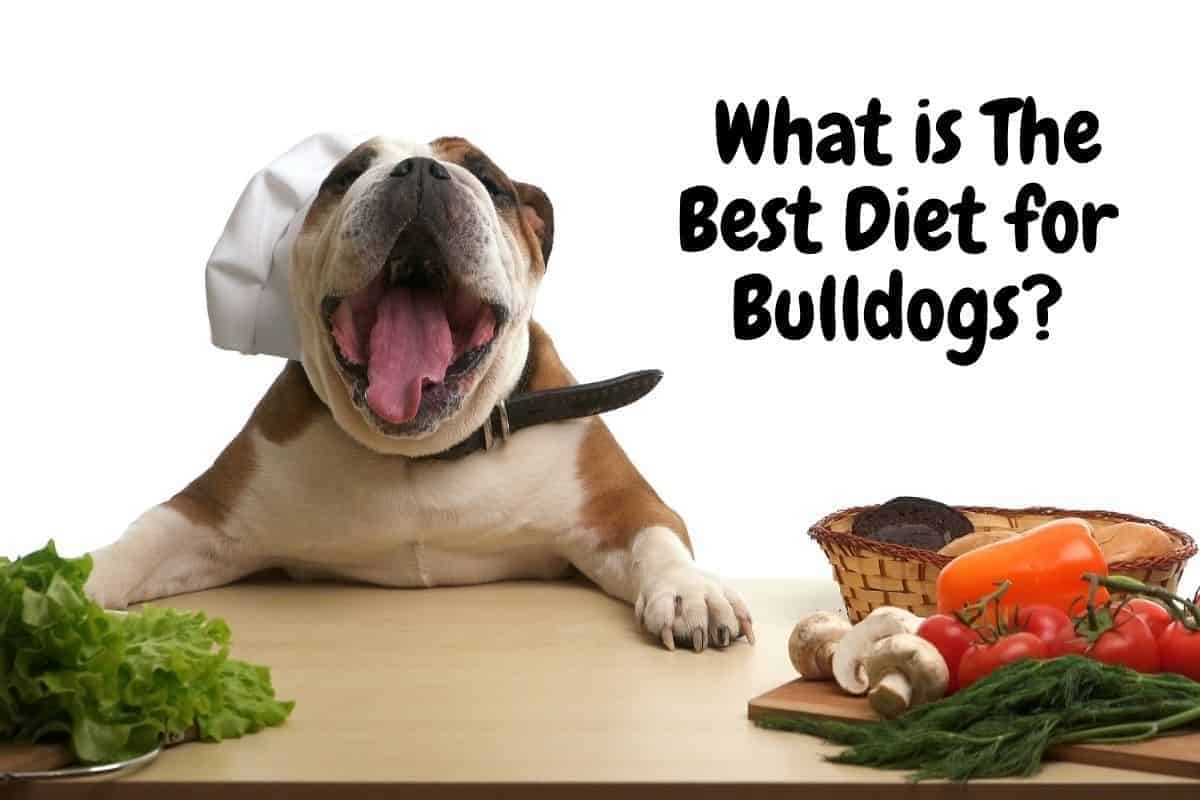
Key Nutritional Requirements
Bulldogs require specific nutritional balances: puppies need at least 22% protein and 8% fat, while adults need at least 18% protein and 5% fat. Carbohydrates, vitamins, minerals, and water are also essential.
Ranked as the 5th most muscular dog breed, Bulldogs require ample protein to maintain muscle mass, unlike smaller, more energetic breeds that need more carbs.
As a general guideline, ensure your Bulldog consumes 1 gram of protein for every lb of body weight. This will ensure he’s consuming sufficient amounts to sustain his lean mass.
Although Bulldogs need fewer carbs than more active breeds, it’s important to choose carbs carefully, as Bulldogs often have food allergies, particularly to carb-rich sources. Whole grains are a good carb choice.
Additionally, Bulldogs benefit from a diet rich in Omega 3 and Omega 6 fatty acids due to their propensity to develop itchy skin, which is found in meat, poultry, and fish.
What Foods Can Bulldogs Eat?
Now that you know what nutrients your dog needs to remain fit and healthy, you must contend that Bulldogs’ stomachs are extremely sensitive.
You can deal with this by making a list of foods they can’t eat or going the simpler path of learning precisely what you can feed your Bulldog.
Bulldogs can eat meat and fish such as pork, beef, chicken, lamb, salmon, tuna, cod, etc. They can also eat fruits and veggies like carrots, pumpkin, apples, and berries, and healthy grains such as brown rice and oatmeal. Dairy foods like cheese and yogurt can be eaten in moderation.
There is also a range of “human food” that Bulldogs can eat, such as organic peanut butter (no xylitol) or a small serving of bread.
During the early years of dog domestication, we mustn’t forget that dogs survived alongside humans by living off leftovers, including scraps of meat, potatoes, and bread.
IMPORTANT POINTS WHEN FEEDING YOUR BULLDOG!
- If a fruit contains pits or seeds, these must be removed as they are toxic in large amounts. They are also a choking hazard and can cause intestinal blockage.
- Most vegetables should be cooked first to help with digestion.
- It’s best not to feed raw eggs or raw fish due to the risk of salmonella or listeria.
- Some Bulldogs are lactose intolerant and can not eat dairy foods.
- Although Bulldogs can eat nuts such as cashews or almonds (macadamia and walnuts are toxic), they are not advised due to their high-fat content, which can cause an upset stomach.
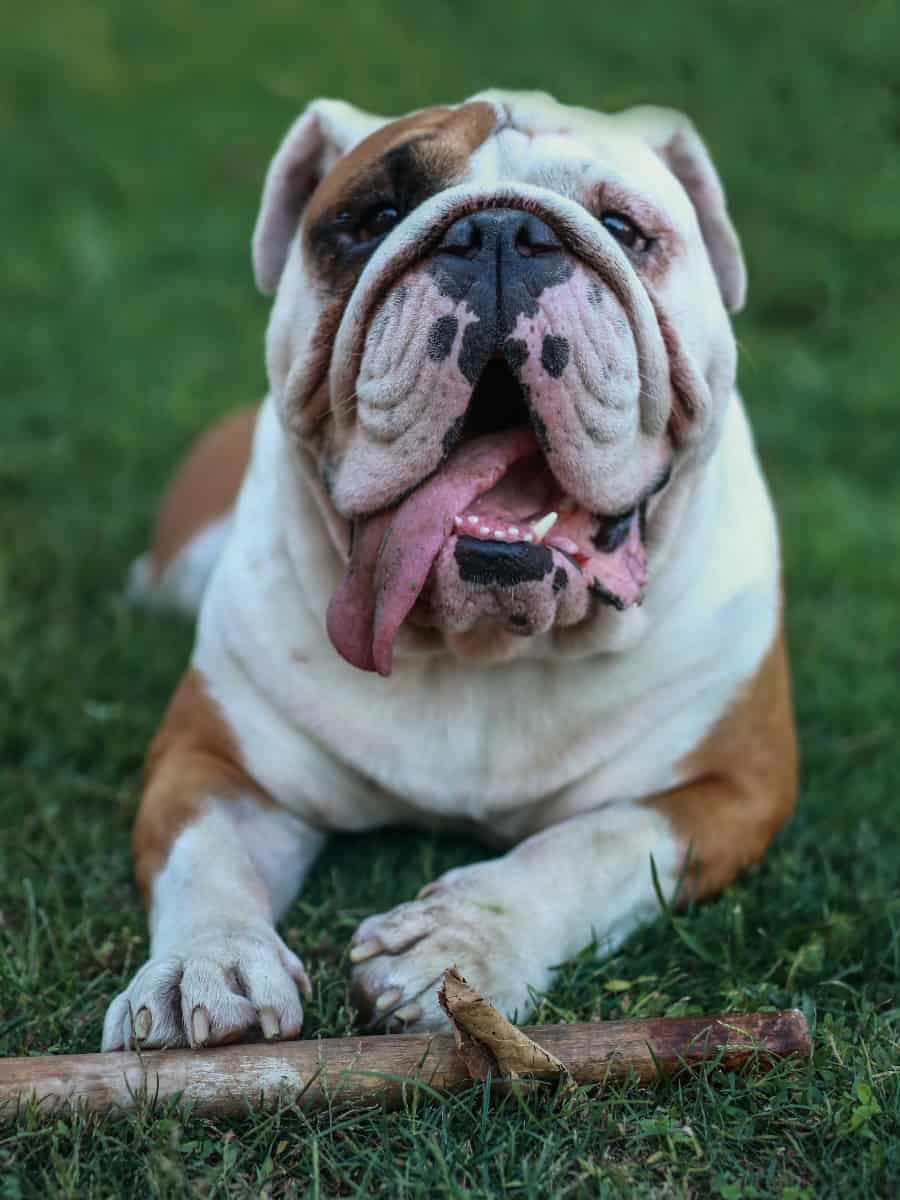
Please note that “can eat” doesn’t mean “should eat!” The definition of food items your Bulldog can eat is simply safe food, and hopefully without causing an adverse reaction.
This is by no means an indication of standard nutrition recommendations. However, it helps you manage how you handle your best friend’s puppy eyes when he’s hoping to get a bite or two during dinner.
If your food belongs to the list above, feel free to let him have a bite or two.
Moderation is key. A good rule of thumb is that treats must make up no more than 10% of your English Bulldog’s diet.
Anything he has besides his meals means you must help him walk it off! Here are the main foods that are safe for your Bulldog to eat.
What Foods Can Bulldogs Eat?
| PROTEINS | GRAINS |
|---|---|
| Beef | Wheat |
| Lamb | Corn |
| Pork | Oats |
| Venison | Oatmeal |
| Chicken | Rice |
| Turkey | Maize |
| Duck | Barley |
| Kidney | Quinoa |
| Liver | Buckwheat |
| Heart | Rye |
| Fish | Teff |
| Salmon | Amaranth |
| Tuna | Bulgar |
| Mackeral | Spelt |
| Eggs | Millet |
| NUTS | DAIRY |
|---|---|
| Peanuts | Milk |
| Cashews | Cream |
| Hazelnuts | Yogurt |
| Almonds | Ice-cream |
| Chestnuts | Cheese |
| VEGETABLES | FRUITS |
|---|---|
| Artichoke | Apple |
| Asparagus | Apricot |
| Beets | Banana |
| Bell Peppers | Blueberries |
| Broccoli | Blackberries |
| Brussel Sprouts | Coconut |
| Cabbage | Cranberries |
| Carrot | Cucumber |
| Cauliflower | Dates |
| Celery & Corn | Kiwi Fruit |
| Eggplant | Mango |
| Green Beans | Melon |
| Lettuce | Nectarine |
| Peas | Peach & Plum |
| Parsnips | Persimmon |
| Potato (cooked) | Olive |
| Pumpkin | Orange |
| Rutabaga | Pear |
| Sweet Potato | Pineapple |
| Spinach | Raspberries |
| Squash | Strawberries |
| Zucchini | Watermelon |
Read more: The Ultimate List of Human Foods Safe For Your Bulldog
One of the key things to remember when feeding human food to your canine companion is that he can’t handle condiments as you do.
So, even though meat is on the menu, you cannot share a bite if your dinner is garlic-heavy or sauteed with onions. In fact, any heavily spiced food is bad for your dog, which leads me nicely to the next section…
What Foods Can Bulldogs Not Eat?
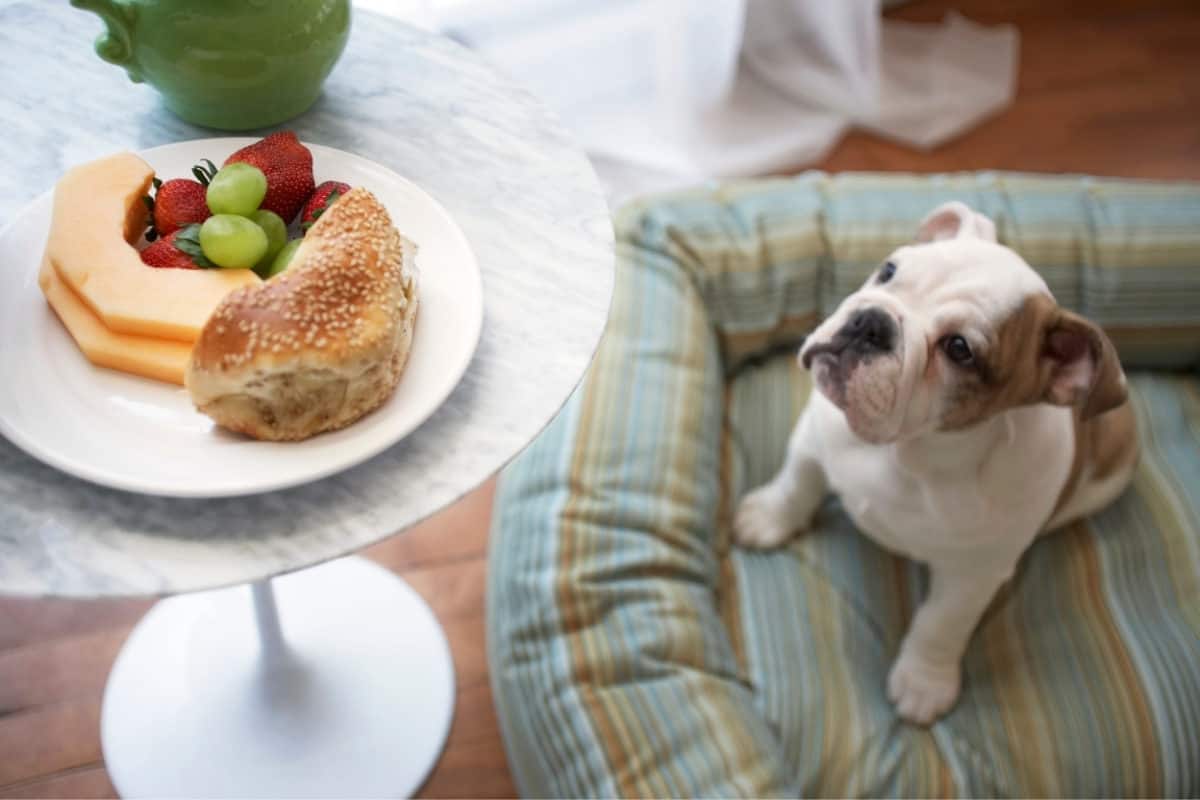
Many foods are toxic to your Bulldog, and it’s crucial to know what these are, as some of the worst offenders, like grapes, can result in kidney failure and death just by consuming a minimal amount. So what foods can Bulldogs not eat?
Bulldogs cannot eat chocolate, grapes, raisins, onions, garlic, macadamia nuts, xylitol (sweetener), ethanol, and unbaked yeast dough, as all of these are toxic. They should also not eat high-sugar products or spicy food.
In general, poisoning episodes in dogs result from a lack of knowledge of the risks these household foods pose to dogs. Here is a handy table of the main foods that are toxic to Bulldogs.
Foods Bulldogs Can Not Eat Due To Their Toxicity…
| Alcohol | Avocado | Caffeine |
| Chocolate | Grapes | Raisins |
| Moldy Food | Cocoa | Macadamia Nuts |
| Mushrooms | Nutmeg | Onions |
| Leeks | Chives | Garlic |
| Rhubarb Leaves | Salt | Starfruit |
| Xylitol (sweetener) | Yeast Dough | Walnuts (Black) |
| Tomato (green) | Raw Potato | Shallots |
| Horse Chestnut | Cherries | Hops |
Best Type of Dog Food For Bulldogs
There are many different types of foods you can feed your dog, such as dry, wet, raw, or home-produced, to name but a few. However, some breeds are better suited to certain types than others.
For example, toy breeds are generally more suited to wet food, whereas giant breeds are more suited to dry foods.
English Bulldogs should be fed a mix of dry and wet food. As a brachycephalic breed having shorter noses and flat faces, their short muzzle makes it harder to pick up food, and chewing and swallowing can be difficult. Choose a small kibble with a unique shape and add wet food that is more palatable.
You may have different ideas, but when choosing dog food, you should always check the food’s list of ingredients and nutritional content.
Dog food must be complete and balanced and meet nutrient profiles established by the Association of American Feed Control Officials (AAFCO).
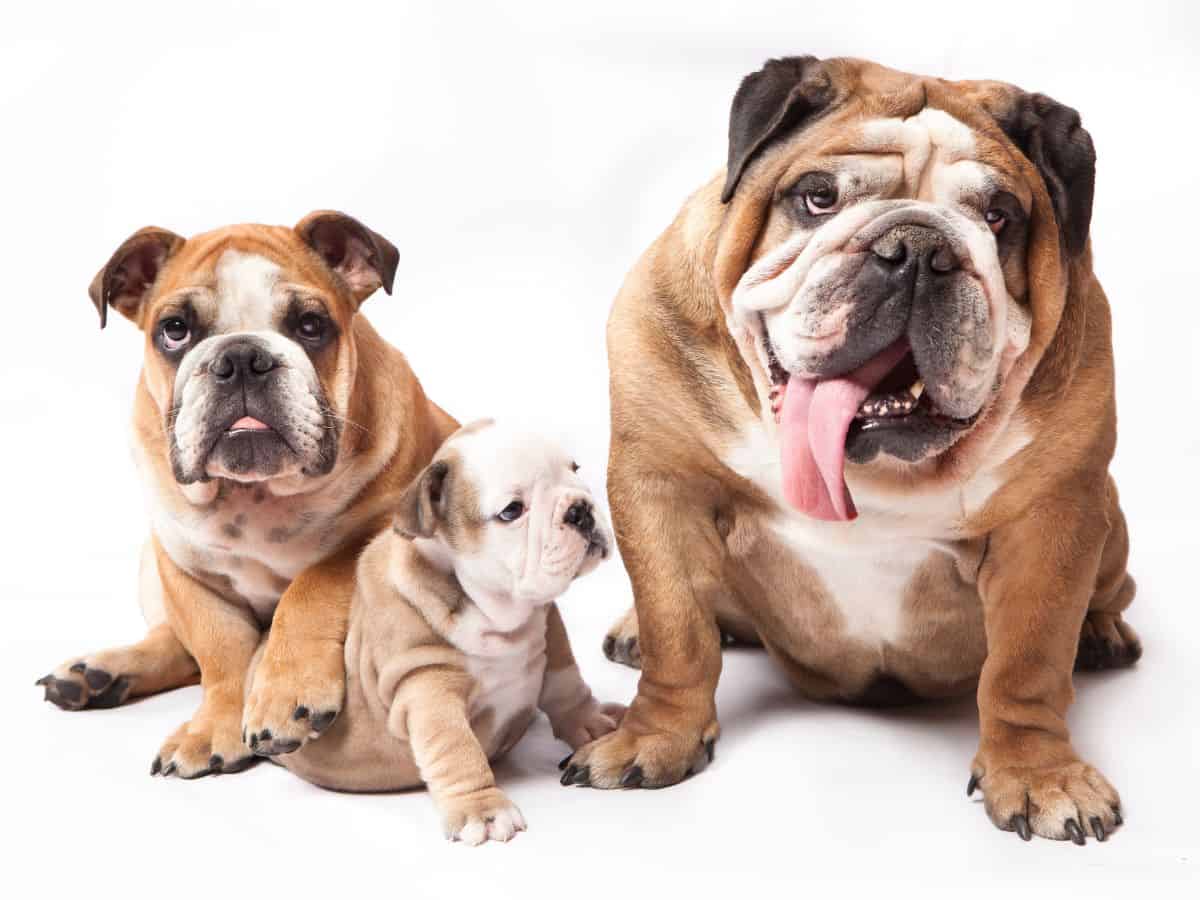
High-quality proteins (beef, pork, chicken, lamb, fish, etc.) should be high on the list, as should quality sources of fats, as these meet all your dog’s nutritional requirements.
The best dog foods include additional protein sources, such as eggs and plant-based proteins like vegetables, legumes, and grains.
Let’s look at the popular kinds of dog foods, which should help you decide on the type to feed your Bulldog…
Dry Food (Kibble)
Many companies manufacture quality dry food for dogs, which usually contains essential nutrients.
Dry food is the best option for easy storage convenience as it doesn’t need refrigeration once opened. It’s also easy to transport, and you can take dry food with you on walks and trips away.
Kibble is also the least expensive and is usually the first choice for medium to large breeds. It’s good for your dog’s teeth, and many owners often add warm water or broth to soften it, increase the aroma, and change the texture.
Check Out This Video to Learn What’s in Kibble…
If you opt for kibble, ensure you choose a top brand that uses high-quality ingredients without added fillers.
There is also a healthier alternative to kibble called cold-pressed dog food, and it’s what I feed my dog.
Cold-pressed foods are cooked at a much lower temperature (and quicker) than extruded kibble, which allows them to retain more nutrients per bite. It’s trendy in the UK and Europe and becoming more widespread in the US and other regions.
Canned Wet Food
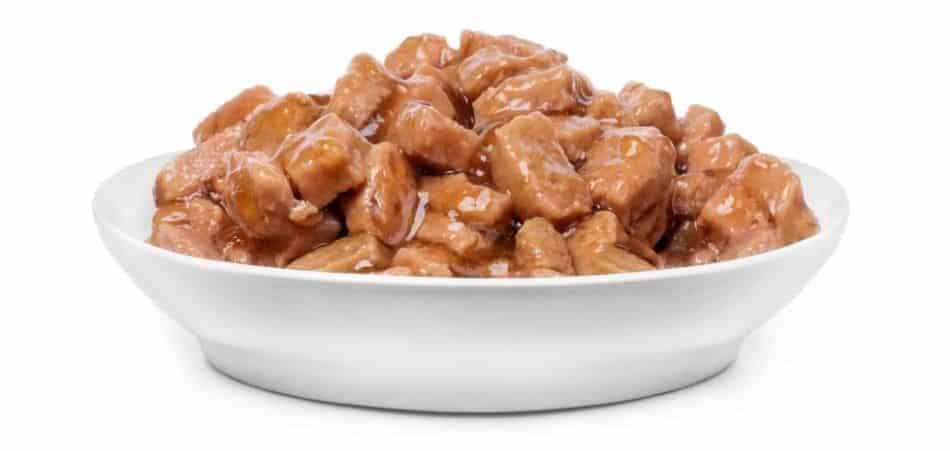
Canned wet food differs from kibble in that it contains much more moisture, takes less chewing, and is generally more appetizing. Your dog is more likely to accept wet food than dry treats.
Adaptability alone can make many turn to canned wet food, though it is messier because of its water content. It’s also much more expensive, especially if you have a large breed.
As stated above, your Bulldog will be suited to a mix of dry and wet, which is exactly what I do.
I feed my dog a diet of quality cold-pressed dog food and add some wet food. Occasionally, I’ll add leftover chicken, beef, or salmon to mix things up for her.
Semi-Moist
If you don’t want the messiness of wet food, but your dog refuses kibble, you can go with a semi-moist food option. Remember that this will be more expensive for energy per lb because about 65% of the food is water.
You must also be cautious and pick a variety that doesn’t contain too much salt and sugar, which are used as a preservative and a flavoring agent, respectively, but aren’t ideal for Bulldogs.
Home Produced Diet
Home-produced diets can save you money but cost more in time. If you’re retired, a stay-at-home parent, or work from home, or preparing food for your dog is semi-therapeutic to you, it makes sense to make two weeks’ worth of Bulldog chow twice every month.
This gives you more control over the macros and can put your mind at ease regarding processing and chemicals in factory-made food.
Learn How to Make Homemade Nutritious and Balanced Dog Food…
If you choose to prepare a home-cooked diet, you should consult your vet or a certified pet nutritionist who has the expertise to customize a healthy diet for your Bulldog.
Raw Diet
Alternatively, you might not find cooking therapeutic but want to control macro nutrition by feeding a raw diet.
Like homemade diets, formulating raw diets can be difficult, especially if your English Bulldog is pregnant or sick and has different nutritional requirements. Again, I recommend that you consult a pet nutritionist.
When feeding your Bulldog a raw food diet, you should also ensure you are fully aware of the safe and proper handling of raw foods and associated food safety issues.
You can also buy commercial raw dog food products. These range from complete frozen foods to grain and supplement mixes combined with raw.
Dehydrated
At first glance, dehydrated food might look like dry kibble, but the manufacturing process is different. Dehydrated food is cured raw dog food, so it has a longer lifespan.
It is cooked at a slight temperature, and moisture is removed using different dehydration techniques. It’s a good choice for Bulldogs with sensitive stomachs as the food is easier on the digestive system due to the gentle cooking process.
When preparing dehydrated dog food, you simply add warm water. It is similar in texture to canned wet food but much less processed.
If you want to retain the nutritional value of a raw diet while having hassle-free storage options, dehydrated might be the best diet for you and your Bulldog.
Freeze Dried
The difference between freeze-dried and dehydrated dog food is, for the most part, cosmetic.
In other words, both types of food contain similar ingredients but use different processes to eliminate moisture/water content. Freeze-drying involves cooking by cooling food so rapidly that moisture turns to ice.
The machine removes said moisture, making the end product a brittle, biteable, solid. It doesn’t need to be rehydrated and is a great alternative to raw, but it can be expensive.
Pros and Cons of Types of Dog Foods
| DRY DOG FOOD | WET FOOD (including semi-moist) |
|---|---|
| More practicable for medium-large breeds | Better suited for toy or small breeds |
| Inexpensive and less waste | Some dogs find wet more appetizing than dry foods |
| Denser-provides more nutrients per bite than wet | Good for fussy eaters and senior dogs |
| Convenient and easy to feed | Good for hydration |
| No need to worry about nutritional deficiencies | No need to worry about nutritional deficiencies |
| Refrigeration not required | Dogs can enjoy a larger portion per meal due to the high water content |
| Good for “grazers” as can be left longer in the bowl | Good for dogs who have trouble chewing |
| Can add “toppings” such as cooked meats, fish, or veg for added variety | Semi-moist may be good for dogs that find foods difficult to digest |
| Add water to make a tasty gravy | Has a longer shelf life than dry, but there can be more waste if the food is uneaten |
| Available in many shapes and sizes to suit your dog | More expensive than dry foods |
| Ideal for interactive feeders and slowing down ‘gulpers’ | Be aware of added salt and sugar in semi-moist |
| Kind to the teeth | May contribute to gum disease |
| Poor quality brands often add “fillers” and low-quality ingredients | Poor quality brands often add “fillers” and low-quality ingredients |
| MIX of DRY & WET | HOME PRODUCED |
|---|---|
| Have the best of both dry and wet | Have complete control of your dog’s diet |
| Can mix in the same bowl or at separate feeds | Good for picky eaters |
| Provides variety | Can help with bonding |
| Recommended to keep to the same brand | Can help with a medical diagnosis or healing |
| Need to track calorie intake | Expensive and time-consuming |
| May require the advice of a pet nutritionist | Need to ensure correct nutrition is fed, so regular health checks are advised |
| RAW | DEHYDRATED & FREEZE-DRIED |
|---|---|
| You control your dog’s food and nutrients | Most of the moisture is removed |
| Need to ensure correct nutrition is given | More natural as no preservatives are added |
| May be unsuitable for senior or sick dogs | Nutrients remain intact |
| Risk of food contamination | Freeze-dried is fundamentally raw |
| No proven health benefits except for improved digestion | Long shelf life and easy to store |
| Expensive and time-consuming if preparing at home | Convenient |
| Regular health checks advised | More expensive |
How Much Food Should a Bulldog Eat?
A Bulldog should eat between 1,000 and 1,200 calories daily, depending on weight, activity level, age, and health.
An inactive adult Bulldog weighing 50lbs (22.5kg) only needs 1,000 daily calories, whereas an active dog of the same weight will need 1,200 calories.
I would always recommend seeking the advice of your vet if you are ever doubtful about what to feed or how much to feed your Bulldog, but you can always refer to the National Research Council’s science-based guide for your dog’s nutritional needs.
So, what about puppies, you may ask? How much food should a Bulldog puppy eat?
On average, a Bulldog puppy needs about twice as many calories per pound of body weight as an adult Bulldog.
Therefore, a puppy weighing 25lbs (11kg) needs around 1,200 calories, the same as an active adult twice its weight. Use feeding charts on dog food labels to find the amount of food for your pup’s weight.
For about ten years before the 2000s, dog feeding relied much more on hunches than quantities. Now that nutrition has advanced hand-in-hand with the dog food industry, we face a double-edged sword.
So, what do I mean by this?
On the one hand, we now know more about how much each breed needs, but at the same time, such messages are being controlled by the dog food industry. That’s why it is crucial not to give in to “package instructions” regarding serving sizes.
With the 1,000 to 1,200 calorie mark for the average adult Bulldog, here’s the process you should go through to figure out how much you need to feed.
Calculate calories per cup
Some manufacturers mislead about serving sizes to increase repeat orders; they’re legally liable if they misrepresent the calorie count. That’s why you should use nutritional information as your initial barometer.
Figure out how much a cup of dog food weighs and find the calories per cup. Some packages have calories listed per cup, making this entire step redundant. The best brands will also have helpful calculators and charts on their websites.
I also found this helpful dog calorie calculator to work out your dog’s daily energy requirements. Just input your dog’s weight and activity level.
For example, if your Bulldog weighs 50lbs (22.5kg) and is inactive, the calculator tells me he needs approximately 1000 calories daily.
Calculate cups per serving
It’s better to feed your Bulldog twice per day. So, once you know how many calories are in a cup, you need to figure out how many cups you need to feed your dog for his 500-600 calories.
Depending on the food, it could be two, three, or even half a cup. Whatever this quantity is, you can work out how much to feed your Bulldog in one sitting.
You’ll need to do this every time you switch to a different brand or change the type of food. Another alternative is to consult a vet nutritionist and determine exactly your dog’s calorie needs.
How Often To Feed Your Bulldog Puppy
Puppies have different nutritional requirements than adult dogs and require more frequent feedings at different stages of development. So, how often should Bulldog puppies be fed?
Bulldog puppies between the ages of 6 and 12 weeks should be fed four meals daily. Puppies between 12 and 24 weeks require three meals a day, and from 24 weeks onwards, Bulldog puppies should be fed twice per day.
| AGE OF PUPPY | MEALS PER DAY |
| 6 to 12 weeks | 4 |
| 12 to 24 weeks | 3 |
| 24 weeks onwards | 2 |
Dogs can sustain themselves on a single meal, provided it meets the calorie needs of the specific breed. But feeding twice a day helps with hunger control, which is great for Bulldogs as they’re prone to obesity.
Spacing out meals is also important for optimal digestion and prevents the life-threatening condition of bloat (GDV).
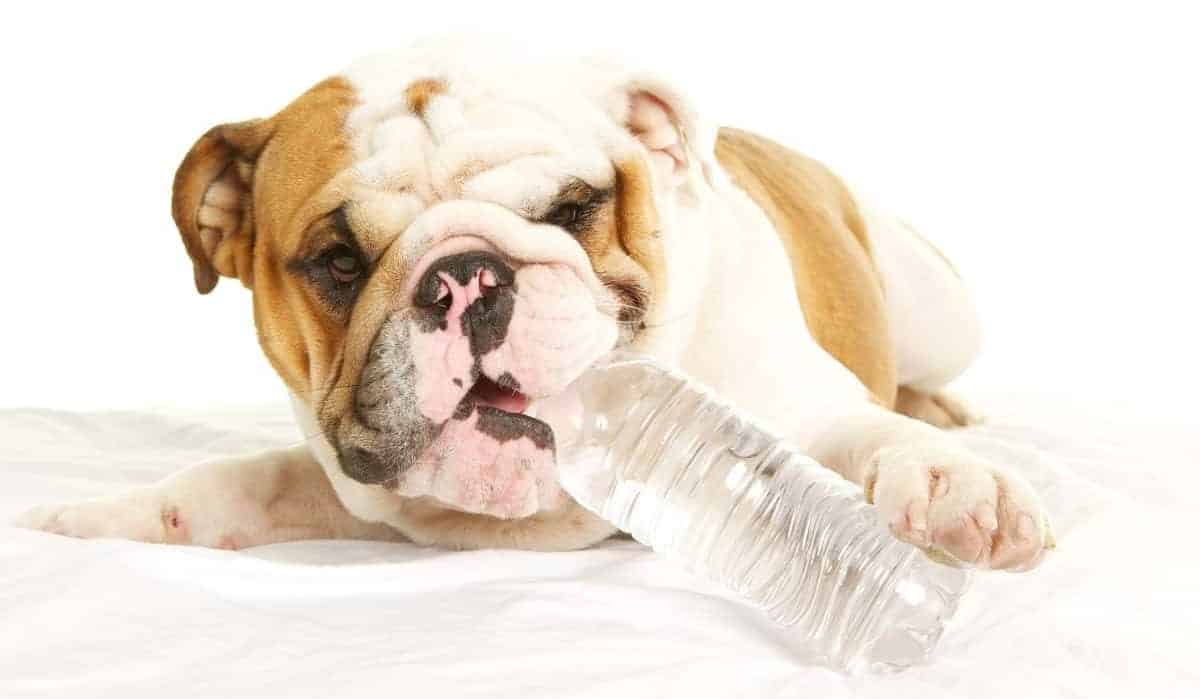
FAQs
How much water should a Bulldog drink?
A Bulldog needs one ounce of water per pound of body weight if he is on a dry food diet and half an ounce per pound if he consumes wet food.
They may drink more water if thirsty or have a higher activity level due to warm weather. Puppies and lactating dogs will also drink more.
Are Bulldogs carnivores?
Bulldogs are not strict carnivores but omnivores. Although meat-based diets are better suited for their digestive system and nutrition requirements, they are adaptive to various foods, textures, and forms.
Can Bulldogs eat bones?
Bulldogs can eat bones but prefer to chew on them rather than swallow them. Dogs can derive nutritional value, such as calcium and phosphorus, from chewing a bone.
Ensure that the bone isn’t cooked, sharp, or brittle. Bones should be raw and larger than your dog’s muzzle.
Are there any dietary restrictions for Bulldogs?
Limit high-glycemic carbohydrates, which can cause pancreatitis. Go for protein-rich foods low in fillers and preservatives. Watch fats, as bulldogs are prone to weight gain.
Provide joint-supporting ingredients like salmon oil, glucosamine and chondroitin. Note: Consult your vet for a personalized diet plan.
How often should I feed my Bulldog treats?
When feeding your Bulldog treats, go easy – too many can lead to weight gain or tummy troubles. 2-3 small treats per day of all-natural ingredients is usually fine.
Avoid feeding treats right before or after meals, and don’t use treats as a substitute for exercise. Pay attention to your Bulldog’s waistline and adjust treat amounts if needed.
How do I transition my Bulldog to a new diet?
To transition your Bulldog’s diet, do so gradually over 5-7 days. Mix a small ratio of the new food into their daily meal, increasing the ratio until fully switched.
This approach is gentler on their digestion. Watch that stools remain firm. If gas or diarrhea occurs, slow the transition.
How many calories should a Bulldog consume per day?
On average, an adult Bulldog should consume 25-30 calories per pound of body weight daily. So a 50-pound bulldog needs around 1,250-1,500 calories. Inactive dogs may need less. Provide this amount split into two meals, and always have fresh, clean water available.
Note: Adjust calorie intake based on your vet’s guidance.
Final Thoughts
Bulldogs may have sensitivities or allergies to specific foods. You should feed them high-quality food and make any dietary changes slowly and cautiously.
Due to their tendency to develop itchy skin and excessive scratching, incorporating fish oil supplements into their diet is often recommended.
Additionally, as Bulldogs age, their diet may need to be adjusted to maintain a healthy weight.





